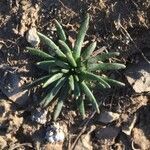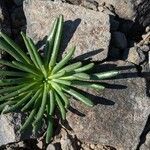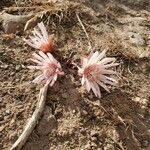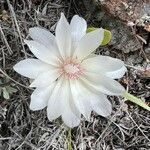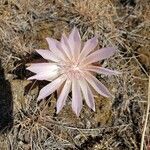Taproots gradually ramified distally. Stems procumbent to erect, 1-3 cm. Leaves: basal leaves withering at or soon after anthesis, sessile, blade linear to clavate, subterete or grooved adaxially, 0.5-5 cm, margins entire, apex obtuse to subacute; cauline leaves absent. Inflores-cences with flowers borne singly; bracts 4-7(-8), whorled, subulate to linear-lanceolate, 4-10 mm, margins entire, apex acuminate. Flowers pedicellate, disarticulate in fruit; sepals (4-)6-9, broadly elliptic to ovate, 10-25 mm, scarious after anthesis, margins entire to somewhat erose, apex obtuse to rounded; petals 10-19, usually rose to pink, sometimes lavender, sometimes with paler or white centers, or wholly white, elliptic, oblong, or narrowly oblanceolate, 15-35 mm; stamens 20-50; stigmas 4-9; pedicel (1-)3-15(-30) mm. Capsules 5-6 mm. Seeds 6-25, 2-2.5 mm, shiny, minutely papillate. 2n = 26, 28.
More
A small plant. The roots are fleshy. It grows 10 cm high and spreads 20 cm wide. It loses its leaves during the year. The leaves are in a dense tuft near the base. They are narrow and 5 cm long. The flowers are white. They occur singly and are 5 cm across. They have up to 6 petals. They can be pink, purple or white.
Gravelly to heavy, usually dry soils. Rocky dry soils of valleys, or on foothills, stony slopes, ridges and mountain summits to about 2,500 metres.
More
It is a temperate plant. In Canada it grows in dry, gravely or sandy soils in the plains and lower mountains. It suits hardiness zones 4-9.
Can be grown by seedlings. Seeds needs stratification.
